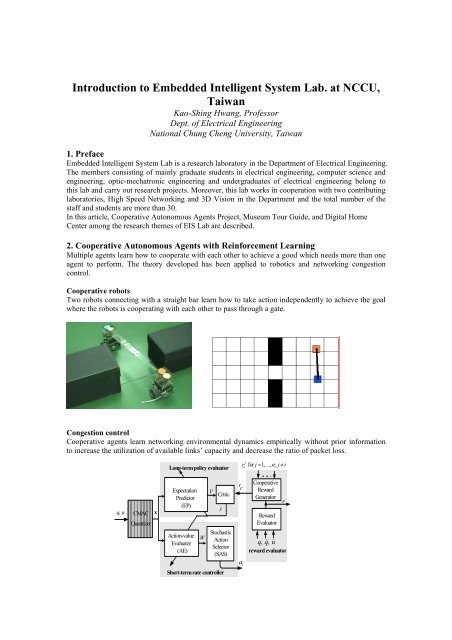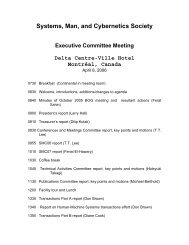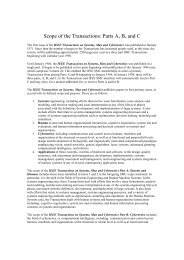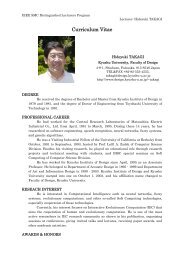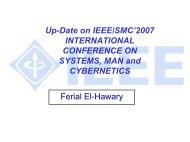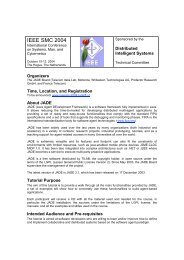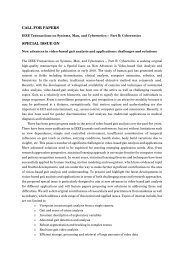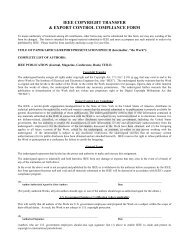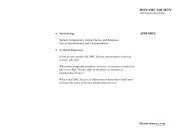Download the pdf file - IEEE Systems, Man, and Cybernetics Society
Download the pdf file - IEEE Systems, Man, and Cybernetics Society
Download the pdf file - IEEE Systems, Man, and Cybernetics Society
Create successful ePaper yourself
Turn your PDF publications into a flip-book with our unique Google optimized e-Paper software.
Introduction to Embedded Intelligent System Lab. at NCCU,<br />
Taiwan<br />
Kao-Shing Hwang, Professor<br />
Dept. of Electrical Engineering<br />
National Chung Cheng University, Taiwan<br />
1. Preface<br />
Embedded Intelligent System Lab is a research laboratory in <strong>the</strong> Department of Electrical Engineering.<br />
The members consisting of mainly graduate students in electrical engineering, computer science <strong>and</strong><br />
engineering, optic-mechatronic engineering <strong>and</strong> undergraduates of electrical engineering belong to<br />
this lab <strong>and</strong> carry out research projects. Moreover, this lab works in cooperation with two contributing<br />
laboratories, High Speed Networking <strong>and</strong> 3D Vision in <strong>the</strong> Department <strong>and</strong> <strong>the</strong> total number of <strong>the</strong><br />
staff <strong>and</strong> students are more than 30.<br />
In this article, Cooperative Autonomous Agents Project, Museum Tour Guide, <strong>and</strong> Digital Home<br />
Center among <strong>the</strong> research <strong>the</strong>mes of EIS Lab are described.<br />
2. Cooperative Autonomous Agents with Reinforcement Learning<br />
Multiple agents learn how to cooperate with each o<strong>the</strong>r to achieve a good which needs more than one<br />
agent to perform. The <strong>the</strong>ory developed has been applied to robotics <strong>and</strong> networking congestion<br />
control.<br />
Cooperative robots<br />
Two robots connecting with a straight bar learn how to take action independently to achieve <strong>the</strong> goal<br />
where <strong>the</strong> robots is cooperating with each o<strong>the</strong>r to pass through a gate.<br />
Congestion control<br />
Cooperative agents learn networking environmental dynamics empirically without prior information<br />
to increase <strong>the</strong> utilization of available links’ capacity <strong>and</strong> decrease <strong>the</strong> ratio of packet loss.<br />
q, u<br />
CMAC<br />
Quantizer<br />
x<br />
Long-term policy evaluator<br />
Expectation<br />
Predictor<br />
(EP)<br />
Action-value<br />
Evaluator<br />
(AE)<br />
W<br />
V<br />
Critic<br />
rˆ<br />
Stochastic<br />
Action<br />
Selector<br />
(SAS)<br />
r<br />
c<br />
r for j= 1, K, n;<br />
j≠i<br />
j<br />
n<br />
K<br />
Cooperative<br />
Reward<br />
Generator<br />
Reward<br />
Evaluator<br />
r<br />
qqu , &,<br />
&<br />
reward evaluator<br />
a t<br />
Short-term rate controller
3. Museum Tour Guide Project<br />
The objective of this project is to develop a mobile device for museum touring by which <strong>the</strong> tourists<br />
can plan <strong>the</strong>ir own visit path around exhibitions. Therefore, manpower <strong>and</strong> related resources of tour<br />
guides can be saved. Besides, <strong>the</strong> tourists can get real-time <strong>and</strong> detailed information for <strong>the</strong> works <strong>the</strong>y<br />
are watching or interested in. The device is designed based on <strong>the</strong> following <strong>the</strong> technologies in<br />
networking <strong>and</strong> embedded systems.<br />
Wireless connections<br />
The mobile device has been equipped with a passive Radio Frequency Identifier (RFID) such that a<br />
visitor can retrieve <strong>the</strong> information of a work via wireless LAN by its index received by <strong>the</strong> RFID.<br />
Recently, a new version with an active RFID is being developed at <strong>the</strong> EIS lab. The h<strong>and</strong>-set device<br />
can, in addition to providing <strong>the</strong> information of <strong>the</strong> works to a visitor approaching his/her interests,<br />
pinpoint <strong>the</strong> visitor’s location <strong>and</strong> provide <strong>the</strong> information about <strong>the</strong> surroundings information<br />
actively.<br />
Open sources<br />
The development is under <strong>the</strong> open source platform <strong>and</strong> utility, such as Embedded Linux for <strong>the</strong><br />
computing power, Qt Embedded for GUI, YAFFS for Flash <strong>file</strong> systems, NFS <strong>and</strong> networking <strong>file</strong><br />
system Coda for connections between <strong>the</strong> stations.<br />
4. Digital Home Center Project<br />
This project aims at intelligent appliances integrating wireless (802.11 WLAN , Bluetooth, RFID) <strong>and</strong><br />
wired (RS-232, RS-485, Power Line Controller) networking technologies to realize an intelligent<br />
networking home system illustrated in <strong>the</strong> following figure.
Mobile control device<br />
The mobile device functions as a SIP Phone, data storage, IR remote controller, <strong>and</strong> video/audio<br />
player. In this modern age, <strong>the</strong> objective of this project is to serve human being for a better life.<br />
5. Conclusion<br />
Wide range of research <strong>and</strong> development on applications of real-time embedded systems, cooperative<br />
agents system, intelligent chip design, etc, based on machine learning <strong>the</strong>ory <strong>and</strong> SOC technology are<br />
carried out in this lab. Please refer to web site of <strong>the</strong> lab for fur<strong>the</strong>r information. URL:<br />
http://www.eis.ee.ccu.edu.tw<br />
Reference<br />
1. Y. B.Hsu, K. S. Hwang, <strong>and</strong> J. S. Wang, " An Associative of CMAC for Mobile Robot Motion Control, "Journal<br />
of Information Science <strong>and</strong> Engineering, Vol. 18, No. 2, pp. 146-161, 2002.(SCI, EI)<br />
2. K. S. Hwang <strong>and</strong> Y. B. Hsu, “A Self-Improving Fuzzy Cerebellar Model Articulation Controller with Stochastic<br />
Action Generation,” <strong>Cybernetics</strong> <strong>and</strong> <strong>Systems</strong>, An International Journalm,Vol. 33, No. 2, pp. 101-128, 2002.<br />
(SCI, EI)<br />
3. K. S. Hwang <strong>and</strong> M. J. Ju, “3D Collision-free Motion Based on Collision Index”, Journal of Intelligent &<br />
Robotic <strong>Systems</strong>, Vol. 33, pp. 45-60, 2002. (SCI, EI)<br />
4. K. S. Hwang <strong>and</strong> M. Y. Ju, ”A Propagating Interface Model Strategy for Global Trajectory Planning among<br />
Moving Obstacle,” <strong>IEEE</strong> Transactions on Industrial Electronics, Vol. 49, pp. 1313-1322, No. 6, 2002. (SCI, EI)<br />
5. M. Y. Ju, J. S. Liu <strong>and</strong> K. S. Hwang, "Real-time Velocity Alteration Strategy for Collision-free Trajectory<br />
Planning of two <strong>Man</strong>ipulators," Journal of Intelligent <strong>and</strong> Robotic System, Vol. 33, pp. 167-186, 2002. (SCI, EI)<br />
6. K. S. Hwang <strong>and</strong> M. Y. Ju, ” Speed planning for a <strong>Man</strong>euvering Motion," Journal of Intelligent <strong>and</strong> Robotic<br />
System, Vol. 33, pp. 25-44, 2002. (SCI, EI)<br />
7. K. S. Hwang, Y. B. Hsu, <strong>and</strong> C. S. Lin, “A Fuzzy CMAC Compensator for <strong>the</strong> Sliding Control,” <strong>the</strong><br />
International journal of Intelligent Automation <strong>and</strong> Soft Computing, Vol.8, No 3, pp. 273-284, 2002. (SCI)<br />
8. K. S. Hwang <strong>and</strong> M. Y. Ju, ”Speed Alteration Strategy for Multi-Joint Robots in Co-Working Environment”,
<strong>IEEE</strong> Transactions on Industrial Electronics, Vol. 50, pp. 385- 393, 2003. (SCI, EI)<br />
9. K. S. Hwang, S. W. Tan, <strong>and</strong> M. C, Tsai, “Reinforcement Learning to Adaptive Control of Nonlinear systems,”<br />
<strong>IEEE</strong> Transactions on <strong>Systems</strong>, man, <strong>and</strong> <strong>Cybernetics</strong>-Part B, Vol.33, No.3, 2003. (SCI, EI)<br />
10. Y. B. Hsu <strong>and</strong> K. S. Hwang, “An Innovative Architecture of CMAC”, IEICE Transactions on electronics, Vol.<br />
E87-C, No. 1, pp.81-93, 2004. (SCI, EI)<br />
11. K. S. Hwang, Y. J, Chen, <strong>and</strong> K. C. Hong, “Autonomous Exploring System Based on Ultrasonic Sensory<br />
Information,” Journal of Intelligent & Robotic <strong>Systems</strong>, Vol. 39, pp.307-331, 2004. (SCI, EI)<br />
12. K. S. Hwang, S. W. Tan, <strong>and</strong> C. C. Chen, ”Cooperative Strategy Based on Adaptive Q-learning for Robot<br />
Soccer <strong>Systems</strong>,” <strong>IEEE</strong> transaction on Fuzzy <strong>Systems</strong>, pp. 569-574, Vol. 12, 2004. (SCI, EI)<br />
13. M. C. Shaio, S. W. Tan, K. S. Hwang, <strong>and</strong> C. S. Wu, “Co-learning Multi-agent Congestion Control for High<br />
Speed Networks”, WSEAS Transactions on Circuits <strong>and</strong> systems, Vol. 21, pp.670-675, 2004.(SCI)<br />
14. K. S. Hwang, S. W. Tan, M. C. Shaio, <strong>and</strong> C. S. Wu, “A reinforcement Learning Approach to Congestion<br />
Control of High-Speed Multimedia Networks," <strong>Cybernetics</strong> <strong>and</strong> System, an International Journal, Vo. 36, No. 2,<br />
pp. 181-202, 2005. (SCI, EI)<br />
K. S. Hwang, S. W. Tan, M. C. Shaio, <strong>and</strong> C. S. Wu, “A Reinforcement Learning Approach to Congestion<br />
Control of High-Speed Multimedia Networks,” <strong>IEEE</strong> transaction on <strong>Systems</strong>, man, <strong>and</strong> <strong>Cybernetics</strong>-Part B,<br />
Vol.35, No. 2, pp 225-pp268, 2005. (SCI, EI)


